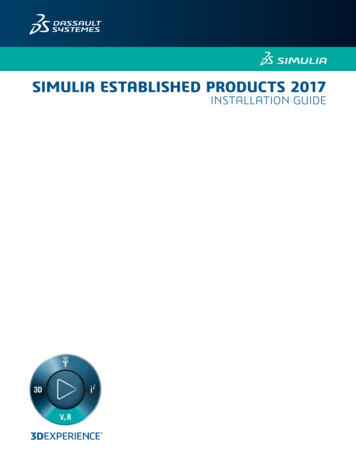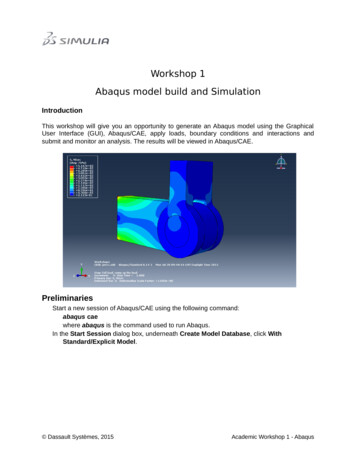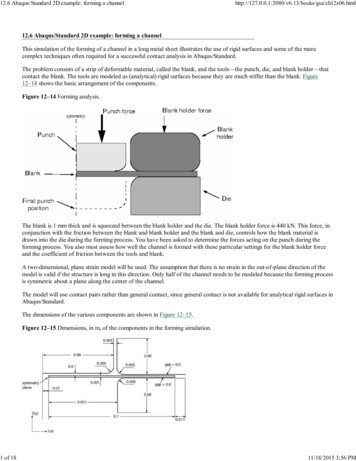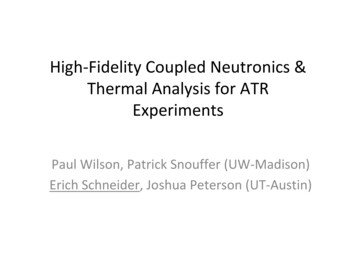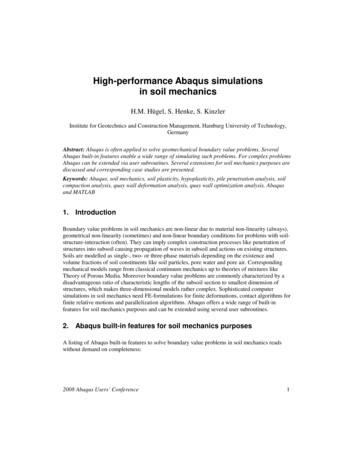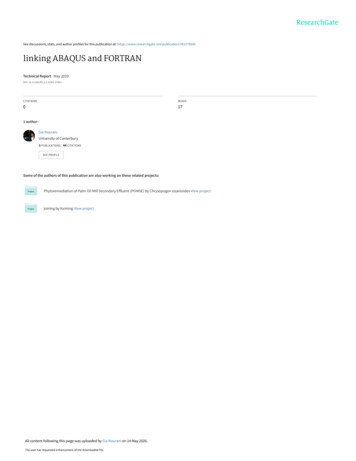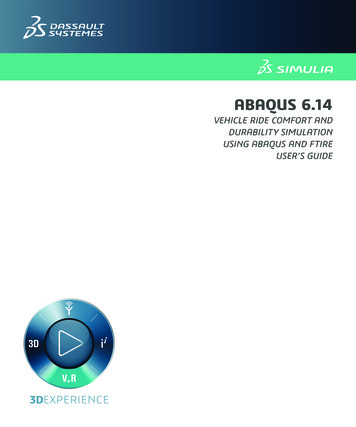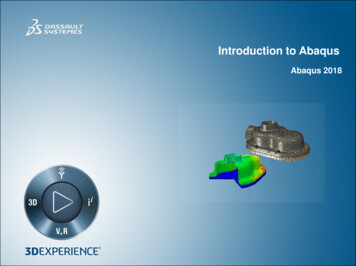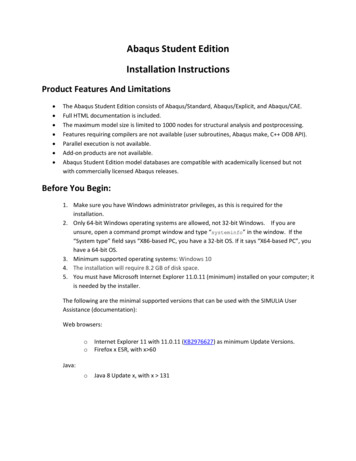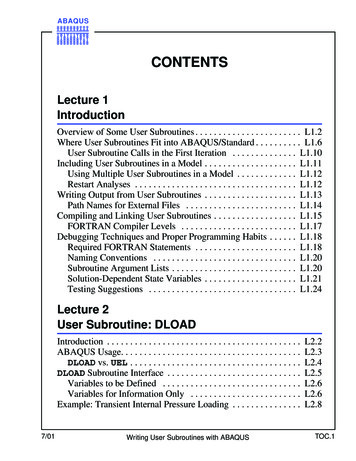
Transcription
ABAQUSCONTENTSLecture 1IntroductionOverview of Some User Subroutines . . . . . . . . . . . . . . . . . . . . . . . L1.2Where User Subroutines Fit into ABAQUS/Standard . . . . . . . . . . L1.6User Subroutine Calls in the First Iteration . . . . . . . . . . . . . . L1.10Including User Subroutines in a Model . . . . . . . . . . . . . . . . . . . . L1.11Using Multiple User Subroutines in a Model . . . . . . . . . . . . . L1.12Restart Analyses . . . . . . . . . . . . . . . . . . . . . . . . . . . . . . . . . . . L1.12Writing Output from User Subroutines . . . . . . . . . . . . . . . . . . . . L1.13Path Names for External Files . . . . . . . . . . . . . . . . . . . . . . . . L1.14Compiling and Linking User Subroutines . . . . . . . . . . . . . . . . . . L1.15FORTRAN Compiler Levels . . . . . . . . . . . . . . . . . . . . . . . . . L1.17Debugging Techniques and Proper Programming Habits . . . . . . L1.18Required FORTRAN Statements . . . . . . . . . . . . . . . . . . . . . . L1.18Naming Conventions . . . . . . . . . . . . . . . . . . . . . . . . . . . . . . . L1.20Subroutine Argument Lists . . . . . . . . . . . . . . . . . . . . . . . . . . . L1.20Solution-Dependent State Variables . . . . . . . . . . . . . . . . . . . . L1.21Testing Suggestions . . . . . . . . . . . . . . . . . . . . . . . . . . . . . . . . L1.24Lecture 2User Subroutine: DLOADIntroduction . . . . . . . . . . . . . . . . . . . . . . . . . . . . . . . . . . . . . . . . . .ABAQUS Usage. . . . . . . . . . . . . . . . . . . . . . . . . . . . . . . . . . . . . . .DLOAD vs. UEL . . . . . . . . . . . . . . . . . . . . . . . . . . . . . . . . . . . . .DLOAD Subroutine Interface . . . . . . . . . . . . . . . . . . . . . . . . . . . . .Variables to be Defined . . . . . . . . . . . . . . . . . . . . . . . . . . . . . .Variables for Information Only . . . . . . . . . . . . . . . . . . . . . . . .Example: Transient Internal Pressure Loading . . . . . . . . . . . . . . .7/01Writing User Subroutines with ABAQUSL2.2L2.3L2.4L2.5L2.6L2.6L2.8TOC.1
ABAQUSPartial Input Data . . . . . . . . . . . . . . . . . . . . . . . . . . . . . . . . . . . . L2.9User Subroutine . . . . . . . . . . . . . . . . . . . . . . . . . . . . . . . . . . . . L2.10Remarks . . . . . . . . . . . . . . . . . . . . . . . . . . . . . . . . . . . . . . . . . . L2.11Example: Asymmetric Pressure Loads . . . . . . . . . . . . . . . . . . . . . L2.12Partial Input Data . . . . . . . . . . . . . . . . . . . . . . . . . . . . . . . . . . . L2.14User Subroutine . . . . . . . . . . . . . . . . . . . . . . . . . . . . . . . . . . . . L2.15Remarks . . . . . . . . . . . . . . . . . . . . . . . . . . . . . . . . . . . . . . . . . . L2.16Lecture 3User Subroutine: FILMIntroduction . . . . . . . . . . . . . . . . . . . . . . . . . . . . . . . . . . . . . . . . . . . L3.2ABAQUS Usage . . . . . . . . . . . . . . . . . . . . . . . . . . . . . . . . . . . . . . . L3.3FILM Subroutine Interface . . . . . . . . . . . . . . . . . . . . . . . . . . . . . . . L3.4Variables to be Defined . . . . . . . . . . . . . . . . . . . . . . . . . . . . . . . L3.5Variables for Information Only . . . . . . . . . . . . . . . . . . . . . . . . . L3.6Example: Radiation in Finned Surface . . . . . . . . . . . . . . . . . . . . . . L3.8Partial Input Data . . . . . . . . . . . . . . . . . . . . . . . . . . . . . . . . . . . L3.12User Subroutine . . . . . . . . . . . . . . . . . . . . . . . . . . . . . . . . . . . . L3.13Remarks . . . . . . . . . . . . . . . . . . . . . . . . . . . . . . . . . . . . . . . . . . L3.15Workshop: User Subroutine FILM . . . . . . . . . . . . . . . . . . . . . . . . L3.16Goals . . . . . . . . . . . . . . . . . . . . . . . . . . . . . . . . . . . . . . . . . . . . L3.16Problem Description . . . . . . . . . . . . . . . . . . . . . . . . . . . . . . . . L3.16Lecture 4User Subroutine: USDFLDIntroduction . . . . . . . . . . . . . . . . . . . . . . . . . . . . . . . . . . . . . . . . . . . L4.2ABAQUS Usage . . . . . . . . . . . . . . . . . . . . . . . . . . . . . . . . . . . . . . . L4.3Defining Field-Variable-Dependent Material Properties . . . . . L4.5Defining Field Variables . . . . . . . . . . . . . . . . . . . . . . . . . . . . . . L4.9Accessing Solution Data at Material Points . . . . . . . . . . . . . . L4.11Explicit vs. Implicit Solution . . . . . . . . . . . . . . . . . . . . . . . . . . L4.127/01Writing User Subroutines with ABAQUSTOC.2
ABAQUSUsing Solution-Dependent State Variables . . . . . . . . . . . . . .User Subroutine GETVRM . . . . . . . . . . . . . . . . . . . . . . . . . . . . . .GETVRM Subroutine Interface . . . . . . . . . . . . . . . . . . . . . . . .Variables Provided to GETVRM . . . . . . . . . . . . . . . . . . . . . . .Variables Returned by GETVRM . . . . . . . . . . . . . . . . . . . . . . .Elements Supported by GETVRM . . . . . . . . . . . . . . . . . . . . . .USDFLD Subroutine Interface . . . . . . . . . . . . . . . . . . . . . . . . . . .Variables to be Defined . . . . . . . . . . . . . . . . . . . . . . . . . . . . .Variables that may be Defined . . . . . . . . . . . . . . . . . . . . . . . .Variables for Information Only . . . . . . . . . . . . . . . . . . . . . . .USDFLD and Automatic Time Incrementation . . . . . . . . . . . .Example: Laminated Composite Plate Failure. . . . . . . . . . . . . . .Material Model . . . . . . . . . . . . . . . . . . . . . . . . . . . . . . . . . . . .Partial Input Data . . . . . . . . . . . . . . . . . . . . . . . . . . . . . . . . . .User Subroutine . . . . . . . . . . . . . . . . . . . . . . . . . . . . . . . . . . .Results . . . . . . . . . . . . . . . . . . . . . . . . . . . . . . . . . . . . . . . . . . .Remarks . . . . . . . . . . . . . . . . . . . . . . . . . . . . . . . . . . . . . . . . 2L4.24L4.27L4.29L4.38L4.41L4.45L4.48Lecture 5User Subroutine: URDFILIntroduction . . . . . . . . . . . . . . . . . . . . . . . . . . . . . . . . . . . . . . . . . . L5.2ABAQUS Usage. . . . . . . . . . . . . . . . . . . . . . . . . . . . . . . . . . . . . . . L5.4Utility Routine POSFIL . . . . . . . . . . . . . . . . . . . . . . . . . . . . . . L5.5Utility Routine DBFILE . . . . . . . . . . . . . . . . . . . . . . . . . . . . . . L5.7URDFIL Subroutine Interface . . . . . . . . . . . . . . . . . . . . . . . . . . . . L5.9Variables to be Defined . . . . . . . . . . . . . . . . . . . . . . . . . . . . . L5.10Variables for Information Only . . . . . . . . . . . . . . . . . . . . . . . L5.11Example: Using URDFIL to Terminate an Analysis . . . . . . . . . . L5.12Input Data . . . . . . . . . . . . . . . . . . . . . . . . . . . . . . . . . . . . . . . . L5.13User Subroutine . . . . . . . . . . . . . . . . . . . . . . . . . . . . . . . . . . . L5.16Remarks . . . . . . . . . . . . . . . . . . . . . . . . . . . . . . . . . . . . . . . . . L5.217/01Writing User Subroutines with ABAQUSTOC.3
ABAQUSLecture 6Writing a UMAT or VUMATOverview . . . . . . . . . . . . . . . . . . . . . . . . . . . . . . . . . . . . . . . . . . . . . L6.2Motivation . . . . . . . . . . . . . . . . . . . . . . . . . . . . . . . . . . . . . . . . . . . . L6.4Steps Required in Writing a UMAT or VUMAT . . . . . . . . . . . . . . . L6.12UMAT Interface . . . . . . . . . . . . . . . . . . . . . . . . . . . . . . . . . . . . . . . L6.20UMAT Variables . . . . . . . . . . . . . . . . . . . . . . . . . . . . . . . . . . . . L6.25UMAT Utilities . . . . . . . . . . . . . . . . . . . . . . . . . . . . . . . . . . . . . L6.28UMAT Conventions . . . . . . . . . . . . . . . . . . . . . . . . . . . . . . . . . L6.29UMAT Formulation Aspects . . . . . . . . . . . . . . . . . . . . . . . . . . . L6.30Usage Hints . . . . . . . . . . . . . . . . . . . . . . . . . . . . . . . . . . . . . . . L6.32Example 1: Isotropic Isothermal Elasticity . . . . . . . . . . . . . . . . . . L6.33Governing Equations . . . . . . . . . . . . . . . . . . . . . . . . . . . . . . . . L6.33Coding for Isotropic Isothermal Elasticity . . . . . . . . . . . . . . . L6.34Remarks . . . . . . . . . . . . . . . . . . . . . . . . . . . . . . . . . . . . . . . . . . L6.36Example 2: Non-Isothermal Elasticity . . . . . . . . . . . . . . . . . . . . . L6.38Governing Equations . . . . . . . . . . . . . . . . . . . . . . . . . . . . . . . . L6.38Coding for Non-Isothermal Elasticity . . . . . . . . . . . . . . . . . . . L6.39Remarks . . . . . . . . . . . . . . . . . . . . . . . . . . . . . . . . . . . . . . . . . . L6.43Example 3: Neo-Hookean Hyperelasticity . . . . . . . . . . . . . . . . . . L6.44Governing Equations . . . . . . . . . . . . . . . . . . . . . . . . . . . . . . . . L6.44Coding for Neo-Hookean Hyperelasticity . . . . . . . . . . . . . . . . L6.47Remarks . . . . . . . . . . . . . . . . . . . . . . . . . . . . . . . . . . . . . . . . . . L6.53Example 4: Kinematic Hardening Plasticity . . . . . . . . . . . . . . . . . L6.54Governing Equations . . . . . . . . . . . . . . . . . . . . . . . . . . . . . . . . L6.54Integration Procedure . . . . . . . . . . . . . . . . . . . . . . . . . . . . . . . L6.56Coding for Kinematic Hardening Plasticity . . . . . . . . . . . . . . L6.58Remarks . . . . . . . . . . . . . . . . . . . . . . . . . . . . . . . . . . . . . . . . . . L6.66Example 5: Isotropic Hardening Plasticity . . . . . . . . . . . . . . . . . . L6.69Governing Equations . . . . . . . . . . . . . . . . . . . . . . . . . . . . . . . . L6.69Integration Procedure . . . . . . . . . . . . . . . . . . . . . . . . . . . . . . . L6.71Coding for Isotropic Mises Plasticity . . . . . . . . . . . . . . . . . . . L6.737/01Writing User Subroutines with ABAQUSTOC.4
ABAQUSRemarks . . . . . . . . . . . . . . . . . . . . . . . . . . . . . . . . . . . . . . . . . L6.83VUMAT Interface. . . . . . . . . . . . . . . . . . . . . . . . . . . . . . . . . . . . . . L6.85VUMAT Variables . . . . . . . . . . . . . . . . . . . . . . . . . . . . . . . . . . L6.90Comparison of VUMAT and UMAT Interfaces . . . . . . . . . . . . . L6.92VUMAT Conventions . . . . . . . . . . . . . . . . . . . . . . . . . . . . . . . . L6.94VUMAT Formulation Aspects . . . . . . . . . . . . . . . . . . . . . . . . . L6.96Example 6: VUMAT for Kinematic Hardening . . . . . . . . . . . . . . . L6.98Coding for Kinematic Hardening Plasticity VUMAT . . . . . . . . L6.99Remarks . . . . . . . . . . . . . . . . . . . . . . . . . . . . . . . . . . . . . . . . L6.105Example 7: VUMAT for Isotropic Hardening . . . . . . . . . . . . . . . L6.107Coding for Isotropic Hardening Plasticity VUMAT . . . . . . . . L6.108Remarks . . . . . . . . . . . . . . . . . . . . . . . . . . . . . . . . . . . . . . . . L6.117Lecture 7Creating a Nonlinear User ElementOverview . . . . . . . . . . . . . . . . . . . . . . . . . . . . . . . . . . . . . . . . . . . . L7.2Motivation . . . . . . . . . . . . . . . . . . . . . . . . . . . . . . . . . . . . . . . . . . . L7.3Defining a User Element . . . . . . . . . . . . . . . . . . . . . . . . . . . . . . . . L7.8Key Characteristics of a User Element . . . . . . . . . . . . . . . . . . . L7.8Other Important Element Properties . . . . . . . . . . . . . . . . . . . . . L7.9Defining the User Element Behavior . . . . . . . . . . . . . . . . . . . L7.10UEL Interface . . . . . . . . . . . . . . . . . . . . . . . . . . . . . . . . . . . . . . . . L7.13ABAQUS Options . . . . . . . . . . . . . . . . . . . . . . . . . . . . . . . . . L7.13Parameter Definition . . . . . . . . . . . . . . . . . . . . . . . . . . . . . . . . L7.14Data Lines . . . . . . . . . . . . . . . . . . . . . . . . . . . . . . . . . . . . . . . . L7.15More on Keywords and Parameters . . . . . . . . . . . . . . . . . . . . L7.19User Element Loads . . . . . . . . . . . . . . . . . . . . . . . . . . . . . . . . L7.22UEL Interface . . . . . . . . . . . . . . . . . . . . . . . . . . . . . . . . . . . . . L7.23UEL Variables . . . . . . . . . . . . . . . . . . . . . . . . . . . . . . . . . . . . . L7.24UEL Conventions . . . . . . . . . . . . . . . . . . . . . . . . . . . . . . . . . . L7.27UEL Formulation Aspects and Usage Hints . . . . . . . . . . . . . . L7.28Coding and Testing the UEL . . . . . . . . . . . . . . . . . . . . . . . . . . L7.307/01Writing User Subroutines with ABAQUSTOC.5
ABAQUSExample 1: Planar Beam Element with NonlinearSection Behavior . . . . . . . . . . . . . . . . . . . . . . . . . . . . . . . . . . . . L7.32Objective . . . . . . . . . . . . . . . . . . . . . . . . . . . . . . . . . . . . . . . . . L7.32Coding Requirements . . . . . . . . . . . . . . . . . . . . . . . . . . . . . . . L7.33Element Formulation . . . . . . . . . . . . . . . . . . . . . . . . . . . . . . . . L7.35Element Definition in the Input File . . . . . . . . . . . . . . . . . . . . L7.39Coding for Planar Beam Example . . . . . . . . . . . . . . . . . . . . . . L7.40Remarks . . . . . . . . . . . . . . . . . . . . . . . . . . . . . . . . . . . . . . . . . . L7.45Generalized Constitutive Behavior . . . . . . . . . . . . . . . . . . . . . L7.46Remarks . . . . . . . . . . . . . . . . . . . . . . . . . . . . . . . . . . . . . . . . . . L7.50Example 2: Force Control Element. . . . . . . . . . . . . . . . . . . . . . . . L7.51Objective . . . . . . . . . . . . . . . . . . . . . . . . . . . . . . . . . . . . . . . . . L7.51Element Formulation . . . . . . . . . . . . . . . . . . . . . . . . . . . . . . . . L7.54Element Definition in the Input File . . . . . . . . . . . . . . . . . . . . L7.56Coding for Force Control Element Example . . . . . . . . . . . . . . L7.57Remarks . . . . . . . . . . . . . . . . . . . . . . . . . . . . . . . . . . . . . . . . . . L7.61Using Nonlinear User Elements in Various Analysis Procedures L7.63Overview of Procedures . . . . . . . . . . . . . . . . . . . . . . . . . . . . . L7.63Perturbation Procedures . . . . . . . . . . . . . . . . . . . . . . . . . . . . . . L7.66Transient Analysis . . . . . . . . . . . . . . . . . . . . . . . . . . . . . . . . . . L7.69Transient Heat Transfer Analysis . . . . . . . . . . . . . . . . . . . . . . L7.70Dynamic Analysis . . . . . . . . . . . . . . . . . . . . . . . . . . . . . . . . . . L7.73WorkshopsWorkshop Preliminaries . . . . . . . . . . . . . . . . . . . . . . . . . . . . . . . . WP.1User Subroutine FILM . . . . . . . . . . . . . . . . . . . . . . . . . . . . . . . . . W1.1User Subroutine UMAT: Tangent Stiffness . . . . . . . . . . . . . . . . . . W2.17/01Writing User Subroutines with ABAQUSTOC.6
ABAQUSLecture 1IntroductionOverview Overview of Some User Subroutines Where User Subroutines Fit into ABAQUS/Standard Including User Subroutines in a Model Writing Output from User Subroutines Compiling and Linking User Subroutines Debugging Techniques and Proper Programming Habits7/01Writing User Subroutines with ABAQUSL1.1
ABAQUSOverview of Some User SubroutinesOverview of Some User Subroutines ABAQUS/Standard provides users with an extensive array of usersubroutines that allow them to adapt ABAQUS to their particularanalysis requirements. Chapter 24 of the ABAQUS/Standard Users’ Manual details all 40 user subroutines available in ABAQUS/Standard.Some popular user subroutines includeCREEP: Use this subroutine to define time-dependent, viscoplasticdeformation in a material. The deformation is divided intodeviatoric behavior (creep) and volumetric behavior (swelling).DLOAD: Use this subroutine to define nonuniform, distributedmechanical loads (pressures and body forces).7/01Writing User Subroutines with ABAQUSL1.2
ABAQUSOverview of Some User SubroutinesFILM: Use this subroutine to describe complex film coefficientbehavior (temperature and field variable dependence) and complexsink temperature behavior.FRIC: Use this subroutine when more complex models than thoseprovided with the FRICTION option are needed to describe thetransmission of shear forces between surfaces. The models definedin this subroutine must be local models (information is providedonly at the node making contact).HETVAL: Use this subroutine to define complex models for internalheat generation in a material, such as might occur when thematerial undergoes a phase change.UEL: Use this subroutine when it is necessary to create elementswith an element formulation that is not available inABAQUS/Standard.7/01Writing User Subroutines with ABAQUSL1.3
ABAQUSOverview of Some User SubroutinesUEXPAN: Use this subroutine to define incremental thermal strainswhen the material’s thermal expansion is too complex to modelwith the EXPANSION option.UEXTERNALDB: Use this subroutine to help manage externaldatabases that may be used by other user subroutine or othersoftware programs that are providing ABAQUS data and/or usingdata generated by ABAQUS.UGENS: Use this subroutine to define complex, nonlinearmechanical behavior for shell elements directly in terms of theshell element’s section stiffness.UMAT: Use this subroutine to define any complex, constitutivemodels for materials that cannot be modeled with the availableABAQUS material models.7/01Writing User Subroutines with ABAQUSL1.4
ABAQUSOverview of Some User SubroutinesUPOREP: Use this subroutine to define the initial pore fluidpressures in a coupled pore fluid diffusion and stress analysis as afunction of node location.URDFIL: Use this subroutine to read the data from the results(.fil) file at the end of an increment. The information can be usedto make decisions such as when to terminate the analysis orwhether to overwrite the results of the previous increment.USDFLD: Use this subroutine to define the values of field variablesdirectly at the integration points of elements. The field variablevalues can be functions of element variables such as stress orstrain.UWAVE: Use this user subroutine to define complex wavekinematics in an ABAQUS/Aqua simulation or to determine whenthe configuration of the model should be updated in a stochasticwave analysis.7/01Writing User Subroutines with ABAQUSL1.5
ABAQUSWhere User Subroutines Fit into ABAQUS/StandardWhere User Subroutines Fit intoABAQUS/StandardWhile a complete understanding of the structure of ABAQUS is notrequired to develop a user subroutine, it helps if the developer has anunderstanding of at least the overall structure.Figure 1–1 shows the basic flow of data and actions from the start of anABAQUS/Standard analysis to the end of a step. Figure 1–2 shows amuch more detailed accounting of how ABAQUS/Standard calculates theelement stiffness during an iteration.In the figures asignifies a decision point in the codeor a specific state (i.e., beginning of increment) during the analysis.Aanalysis.7/01signifies an action that is taken during theWriting User Subroutines with ABAQUSL1.6
ABAQUSWhere User Subroutines Fit into ABAQUS/StandardBeginning of AnalysisUEXTERNALDBDefine Initial ConditionsUPOREPStart of StepStart of IncrementUEXTERNALDBStart of IterationDefine KDLOAD,FILM,HETVAL,UWAVE7/01CREEP, FRIC, UEL,UEXPAN, UGENS,UMAT, USDFLDelDefine Loads RαWriting User Subroutines with ABAQUSL1.7
ABAQUSWhere User Subroutines Fit into ABAQUS/StandardTo Start ofIterationTo Start ofStepTo Start ofIncrementelSolve K c RConverged?αNoWrite OutputUEXTERNALDBURDFILEnd of Step?NoYesFigure 1–1. Global Flow in ABAQUS/Standard7/01Writing User Subroutines with ABAQUSL1.8
ABAQUSWhere User Subroutines Fit into ABAQUS/StandardStart of IncrementCalculate Integration Point Field Variable from Nodal ValuesCREEP: εStart of IterationUELUMATUSDFLDFILM dh d θ ,HETVAL r θ ,crUEXPAN: ε εswthCalculate εFRIC: τ γ σCalculate σ , --------- εUGENS: N EDefine Loads P xDLOAD,UWAVEFigure 1–2. A More Detailed Flow of ABAQUS/Standard7/01Writing User Subroutines with ABAQUSL1.9
ABAQUSWhere User Subroutines Fit into ABAQUS/StandardUser Subroutine Calls in the First Iteration The flow chart in Figure 1–2 is idealized. In the first iteration of anincrement all of the user subroutines shown in the figure are calledtwice.– During the first call the initial stiffness matrix is being formedusing the configuration of the model at the start of the increment.– During the second call a new stiffness, based on the updatedconfiguration of the model, is created. In subsequent iterations the subroutines are called only once.– In these subsequent iterations the corrections to the model’sconfiguration are calculated using the stiffness from the end of theprevious iteration.7/01Writing User Subroutines with ABAQUSL1.10
ABAQUSIncluding User Subroutines in a ModelIncluding User Subroutines in a Model To include user subroutines in an analysis, specify the name of a filewith the user parameter on the ABAQUS execution command.abaqus job my analysis user my subroutineThe file should be either source code (my subroutine.f) or anobject file (my analysis.o). The file extension can be included(user my analysis.f); otherwise, ABAQUS will determineautomatically which type of file is specified.7/01Writing User Subroutines with ABAQUSL1.11
ABAQUSIncluding User Subroutines in a ModelUsing Multiple User Subroutines in a Model When multiple user subroutines are needed in the analysis, theindividual routines can be combined into a single file. A given user subroutine (such as UMAT or FILM) should appear onlyonce in the specified user subroutine source or object code.Restart Analyses When an analysis that includes a user subroutine is restarted, the usersubroutine must be specified again because the subroutine object orsource code is not stored on the restart (.res) file.7/01Writing User Subroutines with ABAQUSL1.12
ABAQUSWriting Output from User SubroutinesWriting Output from User Subroutines The following unit numbers can be used within a user subroutine toread and write data from files:15–18100 In ABAQUS/Standard user subroutines can write debug output to themessage (.msg) file (unit 7) or to the printed output (.dat) file(unit 6).– These units do not have to be opened within the user subroutine—they are opened by ABAQUS.– These unit numbers cannot be used by user subroutines inABAQUS/Explicit.7/01Writing User Subroutines with ABAQUSL1.13
ABAQUSWriting Output from User SubroutinesPath Names for External Files When a file is opened in a user subroutine, ABAQUS assumes that it islocated in the scratch directory created for the simulation; therefore,full path names must be used in the OPEN statements in the subroutineto specify the location of the files.7/01Writing User Subroutines with ABAQUSL1.14
ABAQUSCompiling and Linking User SubroutinesCompiling and Linking User Subroutines When a model that contains user subroutines is submitted to ABAQUS,the correct compile and link commands should be used automatically.– HKS includes the correct compile and link commands for everyplatform on which ABAQUS is supported in the defaultenvironment file (abaqus.env) located in the abaqus dir/sitedirectory.abaqus dir is the directory in which ABAQUS was installed.7/01Writing User Subroutines with ABAQUSL1.15
ABAQUSCompiling and Linking User Subroutines– For example on the Windows NT release, the following commandsare defined in the abaqus dir\site\abaqus.env file:compile ”fl32 /c”link ”link /defaultlib:libf.lib libc.lib user32.libnetapi32.lib advapi32.lib mpr.lib libelm.lib/subsystem:console /out:” If you encounter compile or link errors, check that theabaqus dir\site\abaqus.env file defines the compile and linkcommands. If it does not, please contact HKS. We will provide youwith the correct commands for your system.7/01Writing User Subroutines with ABAQUSL1.16
ABAQUSCompiling and Linking User SubroutinesFORTRAN Compiler Levels The FORTRAN compiler levels used to create ABAQUS are shown atwww.abaqus.com/support on the World Wide Web.– Digital Visual Fortran and Microsoft Visual C must be installedto run user subroutines on computers running Windows NT 4.0. If the version of your FORTRAN compiler does not correspond to thatspecified on the HKS web site, incompatibilities may occur.7/01Writing User Subroutines with ABAQUSL1.17
ABAQUSDebugging Techniques and Proper Programming HabitsDebugging Techniques and ProperProgramming HabitsSome programming habits and suggested debugging techniques arediscussed in this section.Required FORTRAN Statements Every user subroutine in ABAQUS/Standard must include thestatementINCLUDE ‘ABA PARAM.INC’as the first statement after the argument list.7/01Writing User Subroutines with ABAQUSL1.18
ABAQUSDebugging Techniques and Proper Programming Habits The file ABA PARAM.INC is installed on the computer system by theABAQUS installation procedure.– The file specifies either IMPLICIT REAL*8 (A-H, O-Z) fordouble precision machines or IMPLICIT REAL (A-H, O-Z) forsingle precision machines.– The ABAQUS execution procedure, which compiles and links theuser subroutine with the rest of ABAQUS, will include theABA PARAM.INC file automatically.– It is not necessary to find this file and copy it to any particulardirectory: ABAQUS will know where to find it. Every user subroutine in ABAQUS/Explicit must include the statementinclude ‘vaba param.inc’7/01Writing User Subroutines with ABAQUSL1.19
ABAQUSDebugging Techniques and Proper Programming HabitsNaming Conventions If user subroutines call other subroutines or use COMMON blocks topass information, such subroutines or COMMON blocks should beginwith the letter K since this letter is never used to start the name of anysubroutine or COMMON block in ABAQUS.Subroutine Argument Lists The variables passed into a user subroutine via the argument list areclassified as either variables to be defined, variables that can be defined,or variables passed in for information. The user must not alter the values of the “variables passed in forinformation.”– Doing so will have unpredictable results.7/01Writing User Subroutines with ABAQUSL1.20
ABAQUSDebugging Techniques and Proper Programming HabitsSolution-Dependent State Variables Solution-dependent state variables (SDVs) are values that can bedefined to evolve with the solution of an analysis.– An example of a solution-dependent state variable for the UELsubroutine is strain. Several user subroutines allow the user to define SDVs. Within theseuser subroutines the SDVs can be defined as functions of any variablespassed into the user subroutine.– It is the user’s responsibility to calculate the evolution of the SDVswithin the subroutine; ABAQUS just stores the variables for theuser subroutine.7/01Writing User Subroutines with ABAQUSL1.21
ABAQUSDebugging Techniques and Proper Programming Habits Space must be allocated to store each of the solution-dependent statevariables defined in a user subroutine.– For most subroutines the number of such variables required at theintegration points or nodes is entered as the only value on the dataline of the DEPVAR option.*USER MATERIAL*DEPVAR8– For subroutines UEL and UGENS the VARIABLES parameter mustbe used on the USER ELEMENT and SHELL GENERALSECTION options, respectively.*USER ELEMENT, VARIABLES 8– For subroutine FRIC the number of variables is defined with theDEPVAR parameter on the FRICTION option.*FRICTION, USER, DEPVAR 87/01Writing User Subroutines with ABAQUSL1.22
ABAQUSDebugging Techniques and Proper Programming Habits There are two methods available for defining the initial values ofsolution-dependent variables.– The INITIAL CONDITIONS, TYPE SOLUTION option can beused to define the variable field in a tabular format– For complicated cases user subroutine SDVINI can be used todefine the initial values of the SDVs. Invoke this subroutine byadding the USER parameter to the INITIAL CONDITIONS,TYPE SOLUTION option.7/01Writing User Subroutines with ABAQUSL1.23
ABAQUSDebugging Techniques and Proper Programming HabitsTesting Suggestions Always develop and test user subroutines on the smallest possiblemodel. Do not include other complicated features, such as contact, unless theyare absolutely necessary when testing the subroutine. Test the most basic model of the user subroutine before addingadditional complexity to the subroutine.– Whenever a “new” feature is added to the model in a usersubroutine, test it before adding an additional feature. When appropriate, try to test the user subroutine in models where onlyvalues of the nodal degrees of freedom (displacement, rotations,temperature) are specified. Then test the subroutine in models wherefluxes and nodal degrees of freedom are specified.7/01Writing User Subroutines with ABAQUSL1.24
ABAQUSDebugging Techniques and Proper Programming Habits Ensure that arrays passed into a user subroutine with a given dimensionare not used as if they had a larger dimension.– For example, if a user subroutine is written such that the number ofSDVs is 10 but only 8 SDVs are specified on the DEPVARoption, the user subroutine will overwrite data stored by ABAQUS;the consequences of this accident will be unpredictable.7/01Writing User Subroutines with ABAQUSL1.25
ABAQUSLecture 2User Subroutine: DLOADOverview Introduction ABAQUS Usage DLOAD Subroutine Interface Example: Transient Internal Pressure Loading Example: Asymmetric Pressure Loads7/01Writing User Subroutines with ABAQUSL2.1
ABAQUSIntroductionIntroduction User subroutine DLOAD is typically used when a load is a complexfunction of time and/or position.– Loads that are simple functions of time can usually be modeledwith the AMPLITUDE option.– The subroutine can also be used to define a load that varies withelement number and/or integration point number.7/01Writing User Subroutines with ABAQUSL2.2
ABAQUSABAQUS UsageABAQUS Usage The subroutine is called when the DLOAD or *DSLOAD optionscontain a nonuniform load type label.Load type label– For example,*DLOADELTOP,P1NU, 10.0Load magnitudespecifies that the elements in element set ELTOP will be subject to aforce per area on the 1-face of solid (continuum) elements or aforce per unit length in the beam local 1-direction when u
Where User Subroutines Fit into ABAQUS/Standard Writing User Subroutines with ABAQUS L1.10 ABAQUS User Subroutine Calls in the First Iteration The flow chart in Figure 1-2 is idealized. In the first iteration of an increment all of the user subroutines shown in the figure are called twice.
